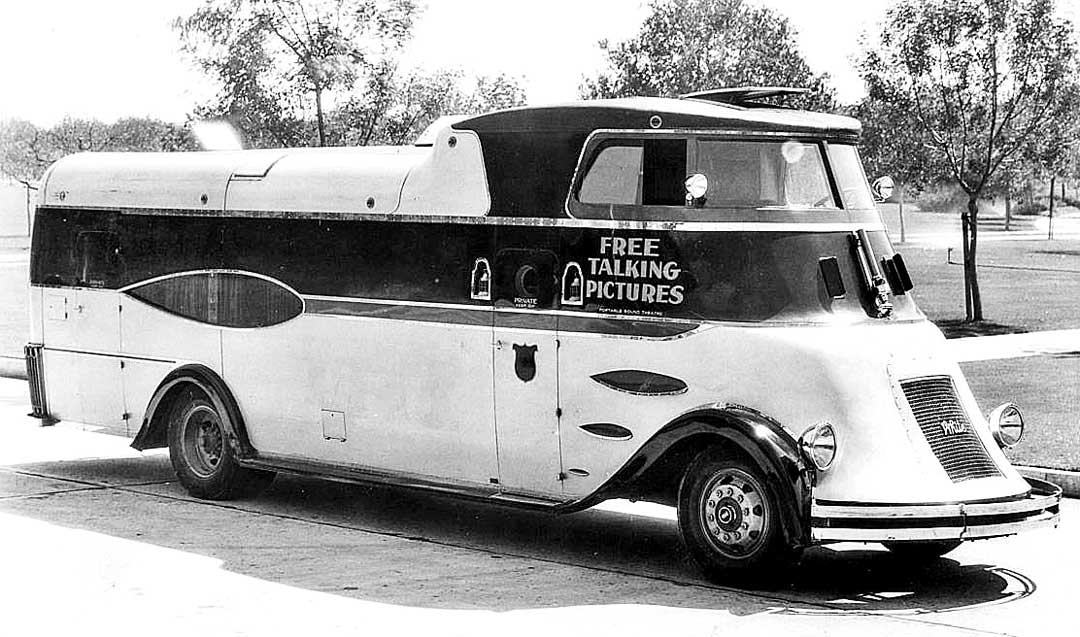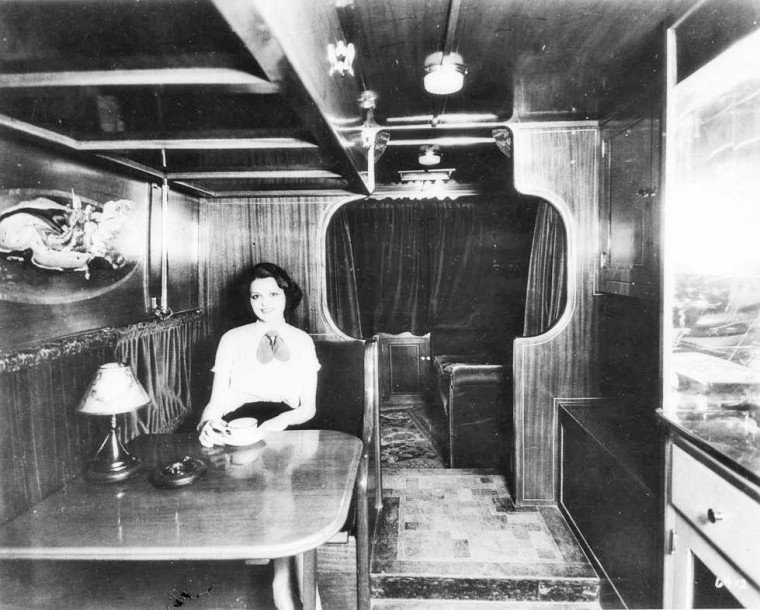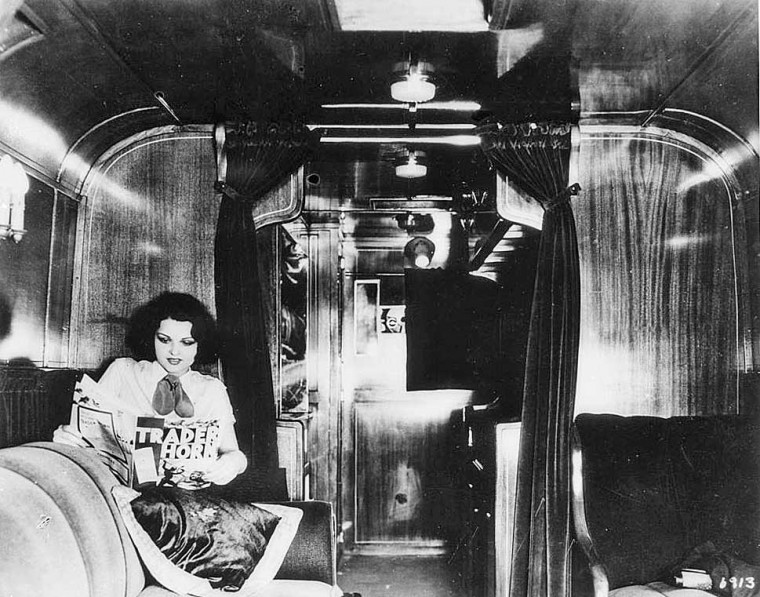The first glance at this unique elevated cab aerodynamic coach based on a White truck chassis brings to mind just how unusual looking it is. The second thought was that this may have been designed and constructed by one of the commercial body builders in the Los Angeles area we learned about in Michael Lamm’s earlier article covering the work of Wellington Everett Miller.
The July 1931 “Modern Mechanics” magazine contains a short article that describes a number of the details of the “traveling talkie theater.” At the rear of the body (below) behind a pair of doors are the movie screen and a sound system that could be viewed and heard by as many as 2,000 people. In front of it, is an enclosed projection room and both are powered by an on-board generator.
In the middle of the 34-foot long black and silver traveling entertainment center are two “Pullman Cars,” pictured below; one is complete with hot and cold running water, a kitchen and a refrigerator; the other room was equipped with a “shower bath” and a comfortable couch and chair arrangement and a sleeping berth.
At the top front of this conveyance was the driver’s “pilot house” that pre-dated the GM 1941 “Futurliners” cab by ten years and was accessible via a stairway from the lower level. A crew of six was scheduled to make a trip with it all around the Country to promote “talking pictures.” The targeted audience lived in smaller communities that were without a movie theater and presumably, would want one after viewing this presentation.
One unanswered question remains, which Southern California film company had this rig constructed, or was it sponsored by the film industry? The answer appears to be shown in the fine print on the side of the cab and the crest on the side door.
A short article in Modern Mechanix contains more images of the rig, the photos are via Yesterday’s Print.





Yikes! I can’t imagine what it must have been like to herd that thing down the street. I suppose that once you are acclimated to it, driving it would become second nature, but still……..
A sumptuous interior.
Like Bill points out, “A sumptuous interior.” Yes in deed. Who ever built it didn’t skimp on anything. I’ll bet those walls are mahogany wood, curtains are velvet. Would have like to see the interior of this when it was around. Like touring the country in your living room.
I wonder if this vehicle influenced the designers at GM when they did do the Future Liners. Can anyone identify what that device is just under the windshield of the pilot house? Looks like it is hinged at the bottom. Could it be a flag holder?
By 1934 this vehicle was called the Esso Cruiser and was being used by Canadian American bandleader, Guy Lombardo.
What body builder created this? 1931 is three years PRIOR to Chrysler’s Imperial using the first curved windshields. So where did these curved windshields come from?
Yes, some of the questions that it was hoped would answered by this post?
The Chrysler Imperial Airflow had the first ONE PIECE curved windshield. The GM Futureliners, which toured the country in 1939 to promote the GM exhibit at the NY World’s Fair that year, had curved windshields like this one.
Some early boats had curved glass, they could make it, but it wasn’t Safety Glass.
Chester PA, 1915 power station control room had curved glass corner windows with woven wire in them, but also not safety glass. Maybe that “pilot house” is high up to protect the curved non-safety glass. ha ha
It occurred to me that the picture could be distorted by the short camera-to-screen distance. It could possibly have had a mirror arrangement so that the projector was pointed forward at the mirror, which then reflected the image to the rear screen. This would also be a means of correcting the otherwise backward image on the rear screen.
The problem with the use of mirrors for projectors is the tremendous loss of light – most mirrors even today only have 60% reflectivity. Of course it’s now possible to make mirrors of 99% reflectivity, but it’s expensive. I don’t know what the availability and cost of such mirrors would have been in the 30’s. Anyhow, wouldn’t an easier solution simply be to flip the film over?
Make a projector to handle the film turned around so it’s right from the other side of the screen. The proper lens will distribute the image on the screen, working in reverse of a camera lens.
Any better mirror would have to be first surface, and that’s not practical out side the lab.
Wow. If it wasn’t documented as 1931, you could see the influence on the nose and body of the Union Pacific M10000. But that didn’t come until’34.
Who designed the actual coachwork itself remains unknown, but the original as-built concept sprang from the fertile mind of Freeman Harrison Owens, a pioneer cinematographer and inventor of cinematic technology who was credited with thousands of inventions and was granted hundreds of patents during his lifetime. Among many other things, if you remember 16mm projectors in school or when the A. C. Nielsen Rating System (his invention) mattered, or if you wear eyeglasses with plastic lens, or like your comics in 3-D, then Owens is the man to thank. Oh, and talking pictures—he had a hand in developing a synchronized sound and film apparatus and went on to make the first synchronized motion picture cameras for Fox Movietone News in 1927. These he demonstrated in Europe, and when his contract with Movietone News expired in June 1928, returned to America and formed the Owens Development Corporation to make inexpensive 16mm projectors. As a side project, on April 1, 1929 he applied for a patent of a “Talking Picture Vehicle” for advertising purposes as stated in the application:
The patent was granted on July 7, 1931 (number 1,813,542), but by that time the “Portable Sound Theatre,” as it was then known (and as the fine lettering under the words “Free Talking Pictures” reads), had been in operation since at least April. The earliest reference of it that I have found so far is from the Sunday, April 5, 1931 issue of The Sedalia Democrat in Missouri and reports it doing exactly what Owens envisioned. While in Sedalia it was at Waldman’s Clothing store to support/advertise a sale on Kuppenheimer clothes, then at C. W. Flower Dry Goods to promote the Ely-Walker line, and finally at the Quinn Brothers Shoe Store to endorse Florsheim shoes. The newspaper article reported that some 4,000 people turned out to see the vehicle (a fare chunk of the population at the time), and noted that it had been christened “Miss Culver City” (perhaps a nod to where it was built?). On Saturday night a crowd of nearly 100 stood blocking traffic to see the free movies—short comedies and a feature picture.
The only other appearance found to date was documented in the Santa Ana Register on Thursday, July 16. It was recorded that “traveling talking picture theater” had appeared in town that week and would return on Sunday for a two day advertising campaign with the Santa Ana Drug company at Fourth and Main streets to promote Harriett Wales’ “Magic Beauty” cosmetic which reduced wrinkles, sagging muscles, crow’s feet, and banished blemishes, blackheads, dry skin, acne, etc. (supposedly used by the likes of Clara Bow and Sally Rand). On both Sunday and Monday nights starting at 7 p.m. there would be three shows featuring comedic, educational, and news films. This article featured a name—Al Sperry was in charge of five other crew members.
There are a few discrepancies between accounts that bear noting, along with some new information concerning how it was equipped. Everyone agreed that it cost $50,000 to build, and in fact this figure would remain constant even into the vehicle’s second incarnation. Often listed as either 10 or 11 tons, the Sedalia paper put the weight at “over twenty-one thousand pounds” (10 ¼ tons) and reported that it was powered by a “160 horse-power motor.” The Santa Ana paper said it was 10 ½ tons and “powered with a 240 horsepower motor.” White’s six-cylinder of the day produced 96 horsepower from factory.
The projector in the July 1931 Popular Science article turns out to be a Pulverman product. According to the July 7, 1931 issue of The Film Daily, “A Royal ‘Z’ sound reproducing apparatus, manufactured by the Pulverman Corp. of Duluth and New York, has been installed in the 34-foot juggernaut of the road that was recently completed in California to bring talking pictures to small towns. The traveling movie theater is equipped to play to an audience of 2,000.” Formerly known as Royal Zenith, this AC powered projector, built specifically for sound-on-film, can be seen in the ad on page 143 in the August 8, 1931 issue of the Motion Picture Herald.
For now, those two articles are the extent of unique reporting on the Portable Sound Theatre, although a handful of newspapers copied the Popular Science article, editing the content to fit available space. However, in the classified ad section of the November 12, 1931 issue of the Los Angeles Times, a rather generic notice appeared in the Business Opportunities column:
ADVERTISING MEN, TAKE NOTICE, BIG
money getter, the largest portable
sound theater on 6-cyl, White chassis:
built for high-class advertising. THE
WHITE CO., 425 E. 20th st.
The White Co., being the Los Angeles branch of the White Motor Company of Cleveland, Ohio, was listed in the Los Angeles City Directory under “Manufacturers—Commercial Cars and Trucks” and now the White-based Portable Sound Theatre was being offered for sale by them. (As an aside, their building still stands at that address in Los Angeles.) At this point we can only speculate on White’s financial interest—if any—in the vehicle. What is known is that “Miss Culver City” was still being offered for sale as late as March, 1932. That ad read:
ADVERTISING MEN
Portable sound theater mounted on
White chassis to handle advertising
program of local & national concerns.
A real producer for sale.
THE WHITE CO., 425 E. 20th st.
From this point the Portable Sound Theatre is absent from the record until it reemerges in September, 1934 under new ownership, with new paint, and with a new mission.
Next installment: The Esso Cruiser
Steve thanks for spending all the time to search and find this information.
When I was a kid my family became friends with an elderly couple who had been in the traveling medicine show business across the south from the 20s to the 40s when that kind of thing petered out. They had a troop of performers that traveled with them & put on blackface comedy shows, rope & bullwhip tricks, showed movies in towns without a movie house and sold Tanico Liquid Balm, a mixture of eucalyptus oil & drinking alcohol for a dollar a bottle. It was advertized to cure anything that ails a body. I highly doubt Doc Hammack had a movie rig like this one, but in their heyday they made good money & lived in style. If he spotted this monster in a 1931 magazine I bet it made his mouth water. His wife, Martha, would have been the age of the woman in the photos but I’m pretty sure it wasn’t her. They did a mail order business selling Tanico Liquid Balm to repeat customers until he died in 1968. They died poor, but were very interesting people. I should have asked more questions & listened a lot harder.
Are the windshields Plexiglass?
No.R and H did not market it until 33 quite a while after its invention.
I recently came across a 3-way fold out advertisement for Tobins First Prize – Albany Packing Company, NY Showing the same truck with photo’s of the interior and advertising the fireproof movie theater. Everything is identical including paint accept for the advertising lettering. Unfortunatly there is no date on the material but it is definatly 1930’s. Is it possible more than one of these were built.
I recently purchased a tri-fold advertisement for Tobin’s First Prize – Albany Packing Company, Inc of NY with the same truck as the front cover. Inside are photo’s of the interior which match those above as well as a detailed description including the fireproof movie room. The exterior, including paint is identical with the acception of lettering for the company. The brochure is definatly 1930’s. I wonder if it was purchased after Guy Lombardo was done with it , or is it possible that two of these vehicles were actually built. I am going to try and find more Info. on the one in my advertisement. It is in my own Town of Colonie so maybe I’ll get lucky.